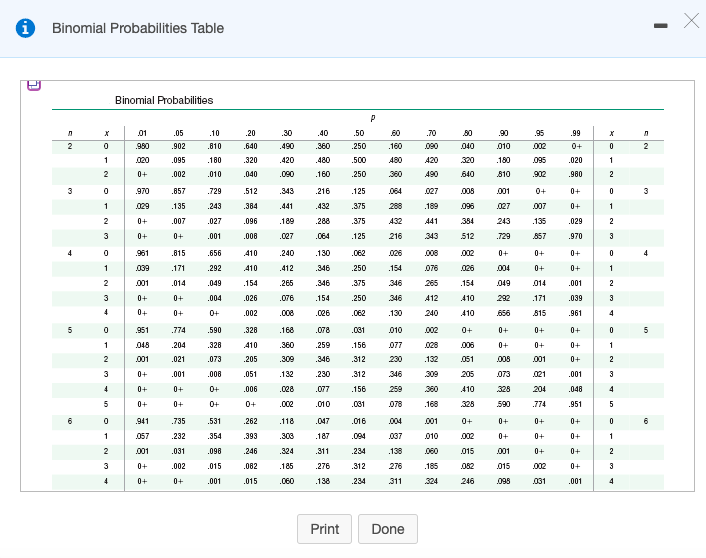Assume that a procedure yields a binomial distribution with n = 2 trials and a probability of success of p = 0.05. Use a binomial probability table to find the probability that the number of successes x is exactly 1. Click on the icon to view the binomial probabilities table. P(1) = (Round to three decimal places as needed.)
Assume that a procedure yields a binomial distribution with n = 2 trials and a probability of success of p = 0.05. Use a binomial probability table to find the probability that the number of successes x is exactly 1. Click on the icon to view the binomial probabilities table. P(1) = (Round to three decimal places as needed.)
College Algebra
7th Edition
ISBN:9781305115545
Author:James Stewart, Lothar Redlin, Saleem Watson
Publisher:James Stewart, Lothar Redlin, Saleem Watson
Chapter9: Counting And Probability
Section9.3: Binomial Probability
Problem 2E: If a binomial experiment has probability p success, then the probability of failure is...
Related questions
Concept explainers
Contingency Table
A contingency table can be defined as the visual representation of the relationship between two or more categorical variables that can be evaluated and registered. It is a categorical version of the scatterplot, which is used to investigate the linear relationship between two variables. A contingency table is indeed a type of frequency distribution table that displays two variables at the same time.
Binomial Distribution
Binomial is an algebraic expression of the sum or the difference of two terms. Before knowing about binomial distribution, we must know about the binomial theorem.
Topic Video
Question

Transcribed Image Text:Binomial Probabilities Table
Binomial Probabilities
.01
.05
.10
.20
.30
.40
.50
60
.70
80
.90
.95
.99
2
.980
.902
.810
.640
.490
.360
.250
.160
090
040
010
002
0+
2
1
020
.095
.180
.320
.420
.480
500
A80
420
.180
095
.020
1
2
0+
.002
.010
.040
.090
.160
.250
360
490
640
810
902
.980
2
3
.970
.857
.729
.512
.343
.216
.125
064
027
008
001
0+
0+
3
1
029
.135
.243
.384
.441
.432
.375
208
.189
095
027
007
0+
2
0+
.007
.027
.096
.189
.288
.375
432
441
384
243
.135
.029
2
3
0+
0+
.001
.008
.027
.064
.125
216
343
512
.729
857
.970
3
.961
.815
.656
410
.240
.130
.062
026
008
002
0+
0+
0+
1
039
.171
.292
410
.412
.346
.250
.154
076
026
004
0+
0+
1
2
001
.014
.049
.154
.265
.346
.375
346
265
.154
049
014
.001
2
3
0+
0+
.004
.026
.076
.154
.250
346
412
410
292
.171
.039
3
4
0+
0+
0+
.002
.008
.026
.062
.130
240
410
656
815
.961
4.
.951
.774
.590
.328
.168
.078
.031
010
002
0+
0+
0+
0+
5
1
048
.204
.328
410
.360
.259
.156
077
028
006
0+
0+
0+
2
001
.021
.073
.205
.309
.346
.312
230
.132
051
008
001
0+
3
0+
.001
.008
.051
.132
.230
.312
346
309
205
073
021
.001
3
4
0+
0+
0+
.006
.028
.077
.156
259
360
410
328
204
.048
5
0+
0+
0+
0+
.002
.010
.031
078
.168
328
590
.774
.951
5
.941
.735
.531
.262
.118
.047
.016
004
001
0+
0+
0+
1
057
.232
.354
.393
.303
.187
.094
037
010
002
0+
0+
0+
2
001
.031
.098
246
.324
.311
.234
.138
060
015
001
0+
0+
3
0+
.002
.015
.082
.185
.276
.312
276
.185
082
015
002
0+
3
4
0+
0+
.001
.015
.060
.138
.234
311
324
246
098
031
.001
4
Print
Done

Transcribed Image Text:Assume that
procedure yields a binomial distribution with n =2 trials and a probability of success of p = 0.05. Use a binomial probability table to find the probability
that the number of successes x is exactly 1.
E Click on the icon to view the binomial probabilities table.
P(1) = (Round to three decimal places as needed.)
Expert Solution
This question has been solved!
Explore an expertly crafted, step-by-step solution for a thorough understanding of key concepts.
This is a popular solution!
Trending now
This is a popular solution!
Step by step
Solved in 2 steps with 4 images

Knowledge Booster
Learn more about
Need a deep-dive on the concept behind this application? Look no further. Learn more about this topic, statistics and related others by exploring similar questions and additional content below.Recommended textbooks for you

College Algebra
Algebra
ISBN:
9781305115545
Author:
James Stewart, Lothar Redlin, Saleem Watson
Publisher:
Cengage Learning

College Algebra
Algebra
ISBN:
9781305115545
Author:
James Stewart, Lothar Redlin, Saleem Watson
Publisher:
Cengage Learning